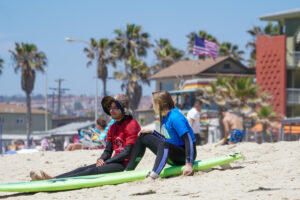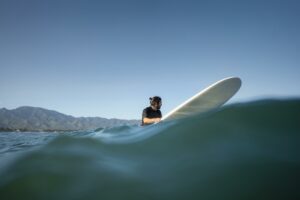People paddling out into the San Diego surf over the years have undoubtedly noticed that surfboards have changed with the times. Originally invented by ancient Hawaiians, the first surfboards were part of a spiritual experience rather than being used for sport as they often are today. Ancient Hawaiians would pray for good surf and had ceremonies surrounding the shaping of boards. The early Hawaiians had two types of boards: the Olo which were ridden by chiefs, and the Alaia which were ridden by commoners. These surfboards were made of solid wood with the Alaia measuring between 10 and 12 feet and the Olo between 14 and 16 feet. Both were heavy and very difficult to maneuver.
Those looking to take surf lessons in San Diego might also be interested to know how those heavy old boards evolved into what we have today. Surfing pioneer Tom Blake invented the Hollow Board in 1926 which was made out of redwood and measured 15 feet but only weighed 100 lbs. The board moved much faster than traditional boards and was the first mass-produced surfboard. Later, in 1935, Blake added to his contributions to the world of surfing by inventing the surfboard fin which increased the board’s stability and maneuverability.
The Hot Curl was introduced by Hawaiian surfers in the early Thirties. This board took from the Hollow Board idea but further shaped the tail so it was no longer square. This development, sure to be appreciated by anyone taking San Diego surf classes, allowed for tighter turns while also helping the board to better fit in the barrel of the wave.
New technology from World War II further improved surfboards. Fiberglass, Styrofoam, and plastic were now available to shapers, and in 1946 Pete Peterson made the first fiberglass surfboard. At the end of the decade Bob Simmins created the Sandwich which had a Styrofoam core surrounded by balsa casing and topped off with fiberglass.
The Sixties and Seventies saw further advances in surfboard technology, specifically in the shortening of the board. Dick Brewer is credited with introducing the world of surfing to the short board which was a mere six feet long. These boards, nicknamed Pocket Rockets, were significantly faster and more maneuverable. Around this time twin fins were also added to boards.
Over the years, further contouring, rail shaping, and more have been experimented with to provide surfers with even more options to find the right board for their surfing style. Without all of the shaping pioneers of past decades none of the speed and amazing tricks seen in the San Diego surf today would be possible. To learn more about the history of surfing or to learn how to paddle out and catch a wave for yourself contact Pacific Surf today.
Photo by Alexandre Capt on Unsplash




